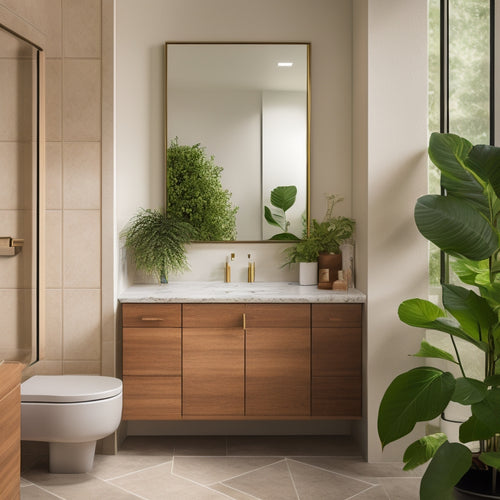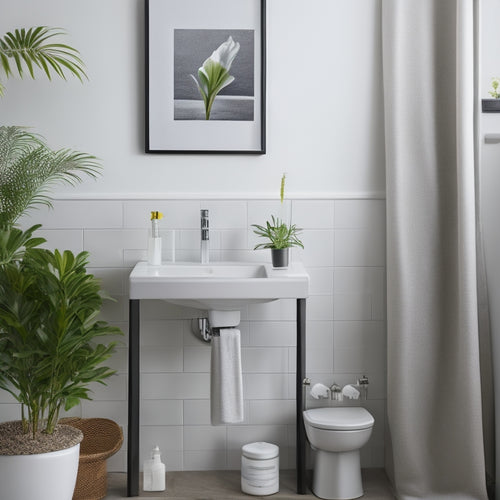
DIY Maven Saves Vanity From Water Damage
Share
A 20-year-old particle board vanity, ravaged by extensive water damage, necessitated immediate attention to prevent further deterioration. Swelling and warping on the side and bottom threatened its structural integrity. To salvage the vanity, a precise repair and restoration process was undertaken. A new template was created, replacement material was carefully cut and securely fastened, and additional support structures were added. The drawers were refurbished with paint and repairs, and the overall aesthetic of the bathroom was upgraded with a neutral wall color and upcycled drawer fronts. The once-damaged vanity now boasts a fresh look, and the story behind its transformation is just as compelling.
Key Takeaways
• Assessing water damage severity is crucial to determine the best repair and restoration approach for a 20-year-old particle board vanity.
• Moisture prevention is key to salvaging the vanity, and understanding damage severity informs the repair and restoration plan.
• A thorough assessment guides the creation of a template, precise cutting of replacement material, and secure fastening for a successful repair.
• Upcycling drawer fronts and replacing bright orange walls with a neutral tone transforms the bathroom's aesthetic and ambiance.
• With a focus on functionality and appearance, the DIY maven's restoration process preserves the vanity's structural integrity, creating a serene oasis.
Assessing the Water Damage
The 20-year-old particle board vanity, worn down by the daily usage of four daughters, had succumbed to extensive water damage on its side and bottom, with the particle board swelling and warping in response to the moisture.
Evaluating the damage, it was evident that the vanity required immediate attention to prevent further deterioration. Moisture prevention was vital to salvaging the vanity, and a thorough assessment revealed the extent of the damage.
The warped and swollen particle board needed to be addressed to restore the vanity's functionality and aesthetic appeal. By understanding the severity of the water damage, a plan could be devised to repair and restore the vanity, rather than replacing it, saving both time and resources.
Repair and Restoration Process
Four essential steps were undertaken to rescue the water-damaged vanity. The first step involved the creation of a template from computer paper to accurately trace and cut a plywood replacement for the damaged side. This critical step guaranteed a precise fit, which is essential in material selection for repair techniques.
Next, the plywood was nailed to the damaged area, providing a solid foundation for the restoration process. To add extra support, 1x4 lumber was installed under the drawers.
Finally, the drawers themselves were refurbished with a fresh coat of paint and minor repairs.
-
Accurate template creation
-
Precise cutting of replacement material
-
Secure fastening of new material
- Reinforcement with additional support structures
Transformation and Upgrades
Beyond the successful repair of the water-damaged vanity, the focus shifted to upgrading the overall aesthetic of the bathroom. A bold and bright orange wall color was replaced with a calming neutral tone, setting the stage for a complete bathroom makeover.
The upcycling of drawers was a pivotal aspect of this transformation. The once-dilapidated drawer fronts were sanded, cleaned, and repainted with acrylic white paint, giving them a fresh new look. This thoughtful renovation not only restored functionality but also elevated the bathroom's ambiance, making it a serene oasis.
Frequently Asked Questions
How Do You Prevent Water Damage From Happening Again in the Future?
"Did you know that 98% of homes experience water damage at some point? To prevent future water damage, install moisture barriers around sinks and toilets, and conduct regular inspections to identify and address potential issues before they become major problems."
Are There Any Specific Safety Precautions to Take When Working With Water-Damaged Materials?
When working with water-damaged materials, take safety precautions seriously, prioritizing personal protection from hazardous materials like mold, asbestos, and lead-based paints; wear gloves, masks, and protective eyewear to minimize exposure and guarantee a safe working environment.
Can This Repair Process Be Applied to Other Types of Damaged Furniture?
When addressing water-damaged furniture, this repair process can be adapted for various pieces, including antique restoration, fostering a furniture revival. By evaluating damage, creating templates, and applying supportive materials, you can revive and restore functionality and aesthetic appeal to cherished pieces.
What Kind of Paint Is Best for Bathroom Furniture to Ensure Durability?
When selecting paint for bathroom furniture, consider durable options that withstand moisture. Acrylic or latex-based paints with a semi-gloss or high-gloss finish offer excellent durability. Additionally, explore color options like soft whites, calming grays, or warm beiges that promote a serene atmosphere.
How Do You Balance DIY Projects With Family Responsibilities and Other Obligations?
To balance DIY projects with family responsibilities and other obligations, effective time management and boundary setting are essential. Prioritize tasks, allocate specific times for DIY projects, and establish clear boundaries to maintain a harmonious balance between personal and family commitments.
Related Posts
-

Sleek Shower Organizers for Contemporary Homes
Sleek shower organizers are essential for a contemporary home, blending aesthetics with function. By utilizing vertic...
-

Stylish Bathroom Layouts Using Drawer Systems
Stylish bathroom layouts come alive with innovative drawer systems that merge practicality and beauty. You're encoura...
-

Top-Selling Bathroom Organization Ebook - Only $0.99
This top-selling bathroom organization eBook, available for instant purchase at an unbeatable price of $0.99, provide...


